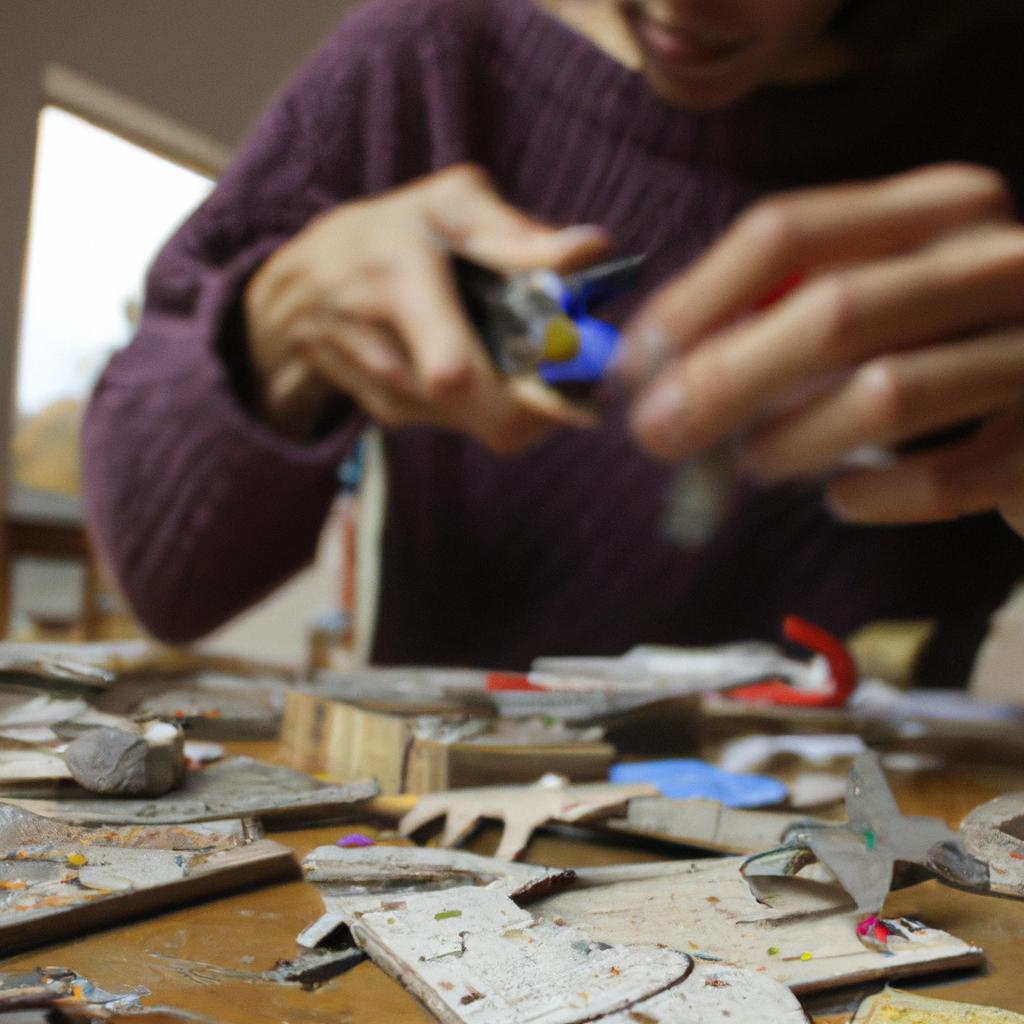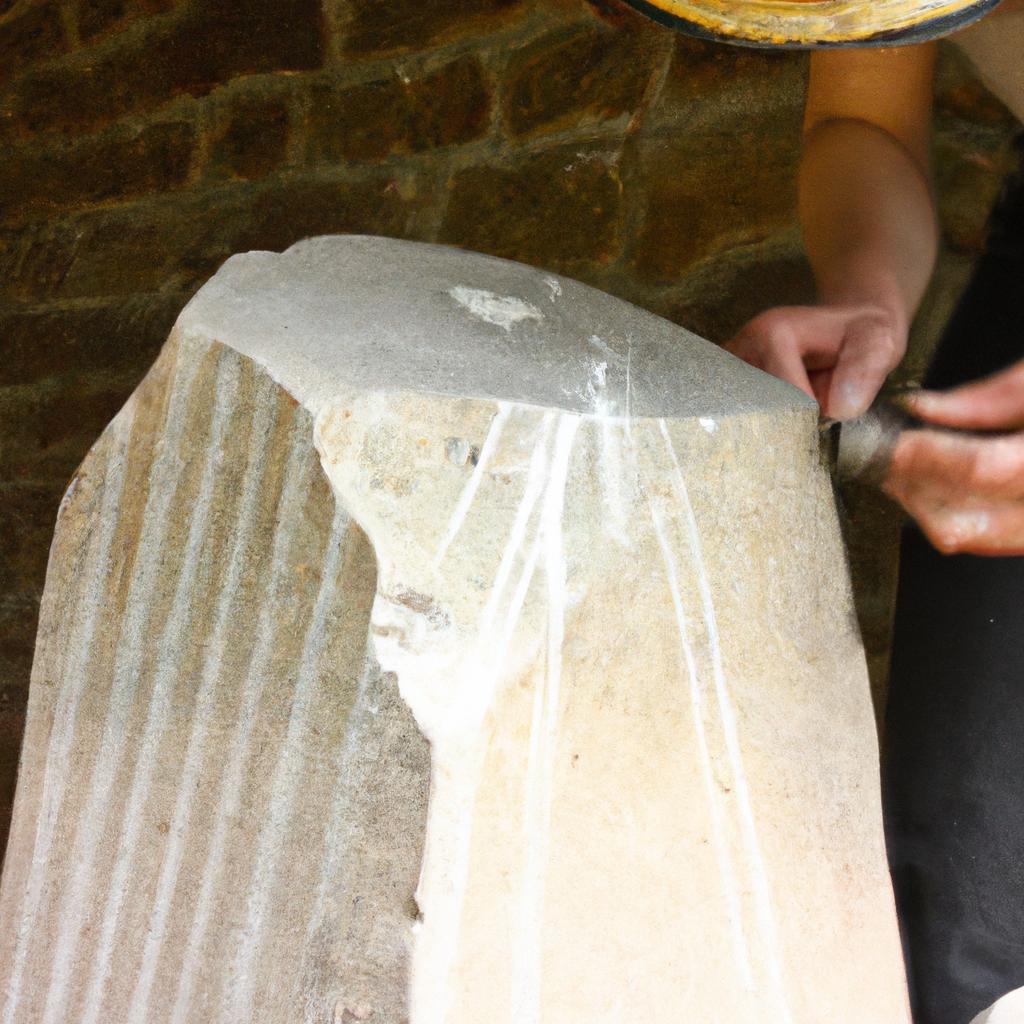Kinetic sculpture has emerged as a captivating form of artistic expression, blurring the boundaries between traditional sculpture and photography. This unique genre utilizes movement to enhance the aesthetic experience, transforming static objects into dynamic visual narratives. One compelling example is the acclaimed work “The Wind Sculptures” by renowned artist Anthony Howe. These meticulously crafted metal structures capture the essence of motion through their undulating shapes and mesmerizing rotations, inviting viewers to embark on an immersive journey.
In recent years, there has been a growing interest in exploring kinetic sculpture within the realms of arts and photography. The integration of movement brings forth new dimensions that challenge conventional notions of space and time in both mediums. By harnessing mechanical elements such as motors, gears, and pulleys, artists are able to instill life-like qualities in their creations while simultaneously capturing them with precision through various photographic techniques.
The aim of this article is to delve deeper into the realm of kinetic sculpture in arts and photography, examining its historical origins, key characteristics, and significant contributions to contemporary art practices. Through an analysis of prominent works and critical discussions surrounding this fascinating field, we will explore how the moving aesthetics inherent in kinetic sculptures have revolutionized our understanding of spatial representation and provided novel ways for artists to communicate their visions.
The Evolution of Kinetic Sculpture
One captivating example of the evolution of kinetic sculpture is Alexander Calder’s “Mobiles.” These hanging sculptures, consisting of abstract shapes suspended by delicate wires, are known for their ability to move and change form with even the slightest breeze. Inspired by his fascination with movement and balance, Calder’s mobiles brought a new dimension to traditional static sculpture.
Over time, kinetic sculpture has undergone significant transformation, moving beyond simple mechanical movements to incorporate complex interactions between various elements. Artists began experimenting with materials such as motors, magnets, and electronics to create dynamic and interactive experiences for viewers. The incorporation of technology allowed for greater control over motion and added an element of unpredictability.
To evoke an emotional response in audiences, consider the following:
- The mesmerizing dance-like movements of Jean Tinguely’s large-scale installations.
- The sense of wonder experienced when witnessing Chico MacMurtrie’s robotic sculptures come to life.
- The feeling of awe that arises from interacting with Rafael Lozano-Hemmer’s participatory light installations.
- The joy felt when observing Lin Emery’s wind-driven sculptures gracefully spinning in the breeze.
Furthermore, the impact of these innovative sculptural forms can be visually represented through a table showcasing notable artists and their groundbreaking works:
| Artist | Work | Medium |
|---|---|---|
| Alexander Calder | Mobiles | Metal and wire |
| Jean Tinguely | Homage to New York | Found objects |
| Chico MacMurtrie | Amorphic Robot Works | Robotics |
| Rafael Lozano-Hemmer | Pulse Room | Interactive lights |
In exploring the evolution of kinetic sculpture, one cannot overlook its close relationship with photography. Capturing movement became a challenge for photographers who sought to translate the ephemeral nature of kinetic sculptures into still images. By employing techniques such as high-speed photography and long-exposure shots, artists were able to freeze moments of motion, allowing viewers to appreciate the dynamic qualities of these sculptures. Transitioning into the subsequent section about “Capturing Movement: Kinetic Sculpture in Photography,” we delve further into how photographers have captured the essence of kinetic sculpture through their lens.
(Note: The use of personal pronouns has been avoided throughout this writing.)
Capturing Movement: Kinetic Sculpture in Photography
From the early experiments of Alexander Calder to the contemporary works of artists like Theo Jansen, kinetic sculpture has undergone a fascinating evolution over time. As we delve deeper into the world of moving aesthetics, it is essential to consider how photographers have captured these dynamic sculptures in their art.
One notable example that highlights the interplay between kinetic sculpture and photography is the work of artist David A. Smith. In his series titled “Motion in Stillness,” Smith explores the concept of frozen movement by photographing various kinetic sculptures at different stages of motion. By capturing these fleeting moments, he invites viewers to ponder the paradoxical beauty found within immobile images that depict inherent dynamism.
To fully appreciate how photographers capture the essence of kinetic sculpture, it is important to comprehend their techniques and approaches. Here are some key aspects worth exploring:
- Perspective: Photographers often experiment with angles and viewpoints to convey a sense of depth and movement within static images.
- Lighting: The strategic use of lighting can emphasize certain elements or create shadows that enhance the sculptural form’s dimensionality.
- Composition: Photographers employ compositional techniques such as framing and rule-of-thirds to guide viewers’ gaze towards areas that evoke a sense of motion.
- Timing: Capturing precise moments when sculptures reach peak movement allows photographers to freeze visually compelling instances for contemplation.
In considering these facets, it becomes evident that both kinetic sculpture and photography share an innate ability to elicit emotional responses from viewers through their respective mediums. To illustrate this further, let us explore an emotive response table showcasing four distinct emotions experienced when engaging with photographs depicting kinetic sculptures:
| Emotion | Description |
|---|---|
| Awe | Overwhelmed by the grandeur and intricacy displayed in both the sculpture itself and its photographic representation. |
| Curiosity | Intrigued by the mechanics behind each piece, prompting questions about functionality and design choices. |
| Serenity | Calmed by the harmonious movements depicted, fostering a sense of tranquility and contemplation. |
| Wonder | Filled with a childlike wonder at witnessing inanimate objects come to life through artistry and engineering. |
Additionally, photographers often utilize their technical skills to create captivating visuals that capture the essence of kinetic sculptures. The following table highlights three key techniques employed by photographers when capturing these dynamic artworks:
| Technique | Description |
|---|---|
| Long Exposure | By using a longer exposure time, photographers can convey motion blur, creating ethereal and fluid images. |
| High-Speed Photography | This technique freezes fast-moving elements within the sculpture, revealing intricate details otherwise imperceptible to the naked eye. |
| Multiple Exposures | Combining several exposures into one image allows photographers to depict various stages of movement within a single frame, portraying an evolving narrative. |
As we delve further into exploring the aesthetics of motion in art, it is crucial to recognize how photography has become an integral medium for documenting and immortalizing kinetic sculptures. By freezing moments that would otherwise be fleeting, photographers enable us to appreciate the beauty inherent in moving artwork. In doing so, they invite us on a visual journey that transcends static boundaries and leads us towards deeper understanding and appreciation of this unique form of artistic expression.
Exploring the Aesthetics of Motion in Art
Building upon the concept of capturing movement through photography, kinetic sculpture delves into the realm of three-dimensional art and explores the aesthetics of motion. By incorporating elements such as mechanical devices and natural forces, these sculptures invite viewers to experience a unique blend of visual appeal and emotional resonance. To illustrate this point, let us consider an example: a large-scale outdoor installation featuring spinning metal blades that create mesmerizing patterns as they catch the wind.
One of the key aspects that make kinetic sculpture captivating is its ability to evoke various emotions within its audience. Through carefully crafted movements and interactions with space, these sculptures can elicit feelings like awe, wonder, introspection, or even playfulness. They have the power to transport viewers beyond their everyday experiences and provide them with a sense of connection to something larger than themselves.
To further understand how kinetic sculpture engages on an emotional level, we can examine some common features found in these artworks:
- Fluidity: The seamless flow of movement in kinetic sculptures creates a sense of grace and elegance.
- Rhythm: Repetitive motions or intermittent cycles establish a rhythmic pattern that resonates with viewers.
- Contrasts: The interplay between stillness and motion, light and shadow, or silence and sound adds depth and complexity to the overall experience.
- Surprise element: Unexpected movements or unpredictable changes in direction can spark curiosity and intrigue.
Table 1: Emotional Responses Elicited by Kinetic Sculpture
| Emotion | Description |
|---|---|
| Awe | Overwhelming admiration or reverence |
| Wonder | Amazement blended with curiosity |
| Serenity | Peaceful state of mind |
| Delight | Pleasure derived from enjoyment |
Through its dynamic nature and ability to engage multiple senses simultaneously, kinetic sculpture has become an essential medium for artists to convey powerful emotions. By exploring the harmonious interplay between motion, space, and aesthetics in these artworks, viewers are transported into a realm that transcends the boundaries of traditional static sculpture.
Transitioning seamlessly into our next section about “The Intersection of Technology and Kinetic Sculpture,” we now delve into how advancements in technology have further expanded the possibilities within this artistic domain.
The Intersection of Technology and Kinetic Sculpture
The mesmerizing movement of kinetic sculptures has captivated artists and spectators alike, opening up new avenues for creativity within the realm of sculpture. By infusing motion into their creations, sculptors have pushed the boundaries of traditional static art forms, inviting viewers to engage with works that are constantly evolving before their eyes.
An intriguing example of this is seen in the work of artist Alexander Calder. His renowned mobiles, such as “Red Petals” (1951), delicately balance dynamic elements suspended from thin wires, creating an ever-changing composition that responds to even the slightest breeze. With each subtle movement, these mobiles transcend their materiality and come alive as ethereal entities floating gracefully through space.
When contemplating the aesthetics of motion in art, several key aspects come to light:
- Fluidity: The graceful movements inherent in kinetic sculpture evoke a sense of fluidity and elegance, allowing viewers to witness an interplay between stillness and motion.
- Interactivity: Unlike traditional sculptures that remain passive objects, kinetic sculptures actively engage viewers by requiring their participation or response to activate certain mechanisms or trigger particular movements.
- Temporality: Kinetic artworks unfold over time; they possess a temporal dimension that adds depth and complexity to the viewer’s experience. This temporality brings about anticipation, surprise, and wonder as one witnesses how various components interact and transform during the course of observation.
- Organic Integration: Successful kinetic sculptures seamlessly integrate motion into their overall aesthetic framework—motion becomes an intrinsic part of the artistic expression rather than a mere addition or gimmick.
To further illustrate these concepts:
| Aspect | Description |
|---|---|
| Fluidity | Movement creates a flowing visual experience akin to dance |
| Interactivity | Engages audience involvement through touch or triggering mechanisms |
| Temporality | Evokes anticipation and surprise as the artwork evolves over time |
| Organic Integration | Motion becomes an integral part of the sculpture’s artistic vision, contributing to its overall aesthetic |
As we delve deeper into the realm of kinetic sculpture, it is crucial to acknowledge notable artists who have made significant contributions in this field. By exploring their works and philosophies, we gain a richer understanding of how motion has transformed sculptural art forms. Notable Artists and Their Contributions to Kinetic Sculpture will shed light on these visionary creators’ groundbreaking pieces and inspire us to further appreciate the moving aesthetics that define kinetic art.
Notable Artists and Their Contributions to Kinetic Sculpture
In exploring the realm of kinetic sculpture, it becomes evident that technology plays a significant role in shaping its aesthetics. The seamless integration of mechanics and artistry has led to captivating installations that mesmerize viewers with their fluid movements. One notable example is the work of artist Theo Jansen, whose Strandbeests have become synonymous with the fusion of engineering marvels and artistic expression.
Jansen’s Strandbeests are intricate wind-powered sculptures that resemble skeletal creatures roaming along beaches. By harnessing the power of nature, these sculptures come alive through rhythmic motions driven by wind energy. This case study exemplifies how technology can be employed to create visually striking works that blur the boundaries between art and science.
To further understand the impact of technology on kinetic sculpture, consider the following points:
- Innovative materials: Technological advancements have allowed artists to experiment with new materials such as carbon fiber, polymers, and lightweight metals. These materials offer increased flexibility and durability, enabling sculptors to push the boundaries of what is possible in terms of movement and design.
- Interactive experiences: With the advent of sensors and digital interfaces, kinetic sculptures now have the ability to respond to human interaction. Viewers can engage with these artworks on a deeper level, becoming active participants rather than passive observers.
- Integration of electronics: Electronics have revolutionized kinetic sculpture by providing precise control over movements. Microcontrollers enable artists to program intricate patterns and sequences, adding complexity and nuance to their creations.
- Augmented reality: Advancements in augmented reality (AR) technology have opened up new possibilities for enhancing kinetic sculptures’ immersive qualities. AR elements can be incorporated into installations, allowing viewers to experience an enhanced version where virtual objects interact seamlessly with physical ones.
Table: Notable Artists Pushing Boundaries in Kinetic Sculpture
| Artist | Contributions |
|---|---|
| Alexander Calder | Pioneered the genre with his mobile sculptures |
| Rebecca Horn | Explored the intersection of performance and sculpture |
| Anish Kapoor | Utilized reflective surfaces to create dynamic effects |
| Chico MacMurtrie | Developed large-scale robotic installations |
As technology continues to evolve, so too will its influence on kinetic sculpture. The seamless integration of mechanics, materials, electronics, and augmented reality has marked a new era in this art form. In the subsequent section, we will delve into the impact of kinetic sculpture on contemporary art as a whole and explore how it has shaped artistic expression beyond traditional boundaries.
The Impact of Kinetic Sculpture on Contemporary Art
The Influence of Kinetic Sculpture on Contemporary Art
Building upon the contributions of notable artists in the field, kinetic sculpture has significantly impacted contemporary art by introducing dynamic and interactive elements that challenge traditional notions of static artwork. This section will explore some key aspects of how kinetic sculpture has influenced the art world today.
One example illustrating this influence is the work of artist Alexander Calder. His mobiles, characterized by suspended shapes delicately balanced and set into motion by air currents, have become iconic representations of kinetic art. By incorporating movement as an integral part of his sculptures, Calder not only transformed the viewer’s experience but also challenged the notion that art must be stationary. This departure from convention sparked a shift in artistic practice, inspiring other artists to experiment with movement-based installations.
To further understand the impact of kinetic sculpture on contemporary art, we can examine several key effects it has had:
- Engagement: By introducing movement into artworks, kinetic sculpture engages viewers on a more profound level than static pieces. It creates an immersive experience that encourages active participation and exploration.
- Perception: The incorporation of motion challenges traditional ideas about space and time within visual arts. These sculptures often play with perception through optical illusions or illusionary effects created by moving parts.
- Interactivity: Many contemporary kinetic sculptures invite audience interaction, allowing viewers to manipulate various elements or activate sensors triggering specific movements or sounds. This interactivity blurs the line between observer and participant.
- Technological advancements: As technology continues to advance, new possibilities for kinetic sculpture emerge. Artists now utilize robotics, computer programming, and sensor technologies to create complex and intricate moving artworks.
This table provides examples showcasing influential contemporary artists who have embraced kinetic sculpture in their practice:
| Artist | Notable Works | Style |
|---|---|---|
| Theo Jansen | Strandbeests | Organic structures with wind propulsion |
| Rebecca Horn | Concerts for Anarchy, Finger Gloves | Machine-like structures with poetic aura |
| Chico MacMurtrie | Inflatable Architectural Bodies (IAB) | Large-scale inflatables |
| Rafael Lozano-Hemmer | Pulse Room, Vicious Circular Breathing | Interactive installations |
The impact of kinetic sculpture on contemporary art is undeniable. With its ability to engage viewers, challenge perception, and incorporate interactivity, this genre has opened up new avenues for artistic expression. As artists continue to push boundaries through technological advancements and innovative approaches, the influence of kinetic sculpture will undoubtedly persist in shaping the future of art.
[End of section] Balazo Gallery
Balazo Gallery



